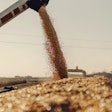
Another harvest is upon us. It’s almost game time. Harvest season reminds me of a scene that I love in the movie Hoosiers (ironically, it’s believed “Hoosier” refers to men from Indiana who helped ship corn on flatboats to New Orleans).
In the scene, a bunch of farm boys from rural Indiana enter the arena they will be playing in for the state basketball championship. You can see the intimidation in the players’ eyes as they enter a much larger gym than they have ever seen. They are trying to take in the relatively large arena and the thought of playing in such a place.
At this point, Gene Hackman, playing their coach in the movie, pulls a tape measure out and has them measure the foul line distance and the height of the basket. “I think you’ll find this gym has the exact same measurements as our gym back in Hickory.” He effectively takes the enormity of the moment and brings them back to some fundamental truths.
While this is not a David versus Goliath state championship and basketball is not our game, sometimes the circumstances we find ourselves in may seem large and overbearing. This new challenge should not change the fundamental principles by which we operate.
Since last August, the merchandising environment has changed. Occasionally the stocks-to-use ratio gets reduced or even stressed as it did last fall, and we found ourselves managing market inversions. Now, we are approaching another harvest season, and the recent volatility may feel big. It will feel like walking into a new arena for some traders since it has been a while since our last significant inverse market. Either way, volatility tends to create emotions. I want to point out some fundamentals of whether the market is at a carry or inverse to help you gain confidence in your trading this year.
Your bid is your baby
Your margin starts with what you buy. If you have done an excellent job of forward contracting, you should have a good start on controlling your buy basis. If not, you will likely be at the mercy of the local market. In times of plenty, the harvest basis is usually the lowest. When there is not plenty, the tendency is to compete for bushels and push basis. While this is the tendency, you do not have to lead the charge. When you provide efficient services during harvest, make sure you are not giving that convenience away because you will have to live with what you buy.
Spreads speak
Spreads tell us when the market wants the grain. This is the tricky part of flat to inverted markets, and most likely, where most of your risk sits. That’s why it is so important to listen to what they are telling you.
当利差缩小在收获的,就像他们did last year, the market is asking for the grain now and will penalize you for holding it. If you hold grain and have not locked in good pre-spreads, you will have to cover the cost of carry with basis improvement, either by working with your end-user to structure a sale or sit on it and hope to capture it in the spot market. Take caution, know your sales values, and have your finger on the trigger. Those opportunities usually do not last long in an inverse environment. Most years like these, you will post your best margins earlier in the selling season. The rest of the year, you will likely be working back to that number. Without the confidence a good spread gives, you will be more apt to take a margin when it presents itself and less likely to wait or push for higher margins. Just because you think the market must pay you for carrying out until the deferred months does not mean it will. If the market does not have carry, it may be wise to ship your inventory early, turn the grain into cash and let that work for you for the next several months.
When spreads are wide enough to cover the cost of carry, then the market is asking you to hold grain. If you have an opportunity ahead of harvest, then you can lock in the carry.
As you buy your harvest position, you have effectively moved your inventory ownership to the deferred periods you set your spread. If you did not have a pre-spread opportunity, but they widen at harvest, adjust the plan from being an aggressive seller to rolling into carries to have supply later in the year.
A word of caution, especially in flat to inverted markets, do not go chasing pennies and end up losing dimes. One thing we were reminded of this past year is the volatility of spreads as you approach a roll date. We saw many roll spread targets within pennies but had to settle for dimes less in the inversion. The risk-to-reward is heavily scaled to the risk side as you approach roll, so get it done if you can make it work.
Logistics have limits
No company can handle all the grain, nor can most companies move it all at once, so you will need to consider logistics in your plan. Depending on truck availability, staffing, loadout capability and several other variables, each elevator’s ability to move grain as the market asks varies. Know your limits. How much per month can you effectively move? If you see you cannot do what the market is asking you to do, adjust and be defensive in positioning yourself within your logistical limits.
Inverted and volatile markets may not be the usual, but remembering these fundamentals will help us have the right frame of mind to manage. At the end of the scene in Hoosiers, the team leaves the arena and a player cups his right hand to his face and yells, “Hickory!” listening to the echo. Coach looks around, smiles, and says to his assistant, “It is big!” Though Gene’s character acknowledges the enormity of the moment, he brought some perspective to his team. The recent market may be looming over our shoulders, but do not be intimidated. You know what to do. ■
Author
Dwayne Wilson和白色的Com是一个粮食营销专家吗mercial Corp. He works with both WCC’s sales and merchandising support teams to help grain elevators across North America grow. Wilson resides in Covington, OH, and can be reached at[email protected].





















